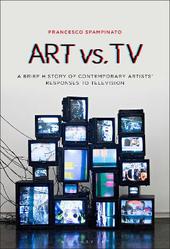
|
Art vs. TV: A Brief History of Contemporary Artists' Responses to Television
Hardback
Main Details
| Title |
Art vs. TV: A Brief History of Contemporary Artists' Responses to Television
|
| Authors and Contributors |
By (author) Dr. Francesco Spampinato
|
| Physical Properties |
| Format:Hardback | | Pages:368 | | Dimensions(mm): Height 229,Width 152 |
|
| Category/Genre | Art and design styles - from c 1960 to now
Television |
|---|
| ISBN/Barcode |
9781501370571
|
| Classifications | Dewey:791.45 |
|---|
| Audience | | Tertiary Education (US: College) | |
|---|
| Illustrations |
105 bw illus
|
|
Publishing Details |
| Publisher |
Bloomsbury Publishing Plc
|
| Imprint |
Bloomsbury Academic USA
|
| Publication Date |
30 December 2021 |
| Publication Country |
United States
|
Description
While highlighting the prevailing role of television in Western societies, Art vs. TV maps and condenses a comprehensive history of the relationships of art and television. With a particular focus on the link between reality and representation, Francesco Spampinato analyzes video art works, installations, performances, interventions and television programs made by contemporary artists as forms of resistance to and appropriation and parody of mainstream television. The artists discussed belong to different generations: those that emerged in the 1960s in association with art movements such as Pop Art, Fluxus and Happening; and those appearing on the scene in the 1980s, whose work aimed at deconstructing media representation in line with postmodernist theories; to those arriving in the 2000s, an era in which, through reality shows and the Internet, anybody could potentially become a media personality; and finally those active in the 2010s, whose work reflects on how old media like television has definitively vaporized through the electronic highways of cyberspace. These works and phenomena elicit a tension between art and television, exposing an incongruence; an impossibility not only to converge but at the very least to open up a dialogical exchange.
Author Biography
Francesco Spampinato is a contemporary art and visual culture historian and writer, and a senior assistant professor (tenure track) at the University of Bologna, Italy. He holds two degrees from the University of Bologna, in Preservation (2003) and Art History (2004), an MA in Modern Art (2006) from Columbia University, New York, and a Ph.D. in Etudes Cinematographiques et Audiovisuelles: Arts et Media (2018) from Sorbonne Nouvelle, Paris. From 2011 to 2015 he was Adjunct Professor at Rhode Island School of Design, Providence, US. His articles have been published in academic journals such as NECSUS, PAJ, Senses of Cinema, the Stedelijk Studies, and Visual Culture Studies, as well as magazines such as Abitare, Blueprint, DIS, Flash Art, Kaleidoscope, and Mousse. He is the author of the following books: Come Together: The Rise of Cooperative Art and Design (2015), Can You Hear Me? Music Labels by Visual Artists (2015), Art Record Covers (2017), and Art Vs. TV: A Brief History of Contemporary Artists' Responses to Television (2021).
ReviewsWhat is and does a work of art? Art can only work framed in a context where it can be seen. Traditionally, that is the museum, gallery, sometimes public space. The space, the curator, then the viewer, become co-makers. With the advent of television, art is set to work in the private sphere. This changes the work of art profoundly. This pioneering study of the relationship between art and television includes reflections on resistance, political tensions, and other ways in which art descends from its isolating pedestal and participates fully in the lives of people. Francesco Spampinato lucidly and patiently lays out what that cultural change entails for what we consider "art" to be and do. * Mieke Bal, Professor Emerita in Literary Theory, University of Amsterdam, the Netherlands * In this exhaustive, scholarly yet entertaining book, Francesco Spampinato traces several decades of relations between art and television. Contemporary artworks dealing with the TV function as a space in which to break down the barriers between high and low culture, explore identity or question power structures. In our current times of on-demand platforms, remembering that age in which television was the center of any home appears, not as an exercise in nostalgia, but as a way to reflect on where we come from and where we are now. Contemporary art here becomes the guiding thread from which to look at ourselves in the mirror of that black screen that will give rise to many others. * Julia Ramirez-Blanco, Lecturer in Art History, University of Barcelona, Spain *
|